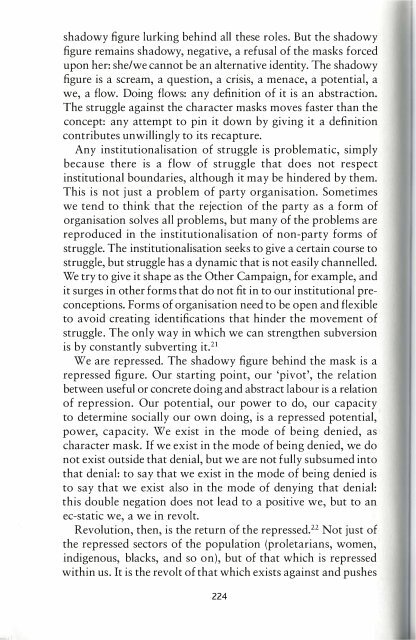Holloway - Crack Capitalism.pdf - Libcom
Holloway - Crack Capitalism.pdf - Libcom
Holloway - Crack Capitalism.pdf - Libcom
Create successful ePaper yourself
Turn your PDF publications into a flip-book with our unique Google optimized e-Paper software.
shadowy figure lurking behind all these roles. But the shadowy<br />
figure remains shadowy, negative, a refusal of the masks forced<br />
upon her: she/we cannot be an alternative identity. The shadowy<br />
figure is a scream, a question, a crisis, a menace, a potential, a<br />
we, a flow. Doing flows: any definition of it is an abstraction.<br />
The struggle against the character masks moves faster than the<br />
concept: any attempt to pin it down by giving it a definition<br />
contributes unwillingly to its recapture.<br />
Any institutionalisation of struggle is problematic, simply<br />
because there is a flow of struggle that does not respect<br />
institutional boundaries, although it may be hindered by them.<br />
This is not just a problem of party organisation. Sometimes<br />
we tend to think that the rejection of the party as a form of<br />
organisation solves all problems, but many of the problems are<br />
reproduced in the institutionalisation of non-party forms of<br />
struggle. The institutionalisation seeks to give a certain course to<br />
struggle, but struggle has a dynamic that is not easily channelled.<br />
We try to give it shape as the Other Campaign, for example, and<br />
it surges in other forms that do not fit in to our institutional preconceptions.<br />
Forms of organisation need to be open and flexible<br />
to avoid creating identifications that hinder the movement of<br />
struggle. The only way in which we can strengthen subversion<br />
is by constantly subverting itY<br />
We are repressed. The shadowy figure behind the mask is a<br />
repressed figure. Our starting point, our 'pivot', the relation<br />
between useful or concrete doing and abstract labour is a relation<br />
of repression. Our potential, our power to do, our capacity<br />
to determine socially our own doing, is a repressed potential,<br />
power, capacity. We exist in the mode of being denied, as<br />
character mask. If we exist in the mode of being denied, we do<br />
not exist outside that denial, but we are not fully subsumed into<br />
that denial: to say that we exist in the mode of being denied is<br />
to say that we exist also in the mode of denying that denial:<br />
this double negation does not lead to a positive we, but to an<br />
ec-static we, a we in revolt.<br />
Revolution, then, is the return of the repressedY Not just of<br />
the repressed sectors of the population (proletarians, women,<br />
indigenous, blacks, and so on), but of that which is repressed<br />
within us. It is the revolt of that which exists against and pushes<br />
224

















